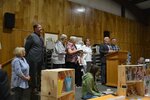



On Saturday, April 1, community and state leaders met at the Bolivar Elks Lodge during the Spring Small Business and Craft Expo to recognize Patty Steinshouer, a local author, for her books that were transcribed to Braille and donated to Polk County Library.
Mayor Chris Warwick and Representative Mike Stephens were in attendance at the event to thank and congratulate Steinshouer and to discuss the importance and accessibility of Braille to the blind and visually impaired.
Colleen Knight, director of the Polk County Library, accepted Steinshouer’s books on behalf of the library, saying that the local author’s books will be the first Braille works to be added to the library. She also detailed some of the services that the library provides for the blind and visually impaired.
Not only does Polk County Library circulate large print materials and audiobooks, the library also provides a free resource through the statewide Wolfner Library service. Wolfner Library offers fiction and nonfiction audio, Braille, large print books, and other items for all ages. Materials can be mailed to and from library patrons at their homes with postage paid.
Applications can be found at the library or at https://www.sos.mo.gov/wolfner/applyforservices. For more information about Wolfner Library, contact Polk County Library at 417-326-4531.
Braille in Books
Steinshouer’s books were printed in Braille through the efforts of The Legends Project, a Missouri organization dedicated to making Braille materials and education available to the general public.
At the ceremony, Frank Taylor and Mary Weber of The Legends Project, noted that around 150,000 people are considered legally blind or severely legally impaired in the state of Missouri. Many of these vision impairments, like muscular degeneration, diabetic retinopathy, cataracts, and glaucoma, usually affect individuals 65 years of age and older.
“Literacy is the key to success for any individual,” Taylor said in his presentation, further stating that those who are blind or visually impaired access literacy through works in Braille. Therefore, the need for Braille is crucial in order to ensure that everyone has access to written information.
The Legends Project is currently rooted in the Ozarks, but Taylor says that they are hoping to expand the organization’s influence beyond Missouri.
Steinshouer promoted her books at the Elks Lodge’s Small Business and Craft Expo last November when Taylor and Weber met her and mentioned transcribing her books into Braille. Steinshouer wholeheartedly agreed to the idea.
“We were just kind of getting things started with the organization at that time, and so all of a sudden, it just erupted and we decided that Patty’s books were going to be the cornerstone of everything we do in this area in the state of Missouri,” said Taylor. “So we Brailled those books, and we decided that at the next event — which was this — we were going to set this up to introduce her books, because she is a local author. And that’s what we want to do is have local authors from the various regions where we’re at, so that we can have books that are available from people that people know in that area.”
The actual process for transcribing materials into Braille is rather lengthy and detailed. Taylor’s daughter Emily oversees what they call “Braille preparation.” During this process, she puts the entire document into an electronic format. She will then “move it around to make sure that it fits into an invisible box,” which is reproduced into a pre-Braille status. It will be aligned and checked before moving into a post-Braille status, where it is ready to be converted into Braille.
A blind proofreader will read the Braille to ensure it is correct. Any mistakes that need to be fixed will be corrected before beginning the embossing process. As Taylor says, this phase is where the material gets placed into a machine, which makes a “noise like a machine gun for several hours” in order to create the Braille document. The document is placed into binders with covers and is ready to be produced.
It took five months to make just two of Steinshouer’s books.
Braille materials can often be expensive as well. Taylor says that to transcribe just one school textbook into Braille can cost anywhere near $20,000 to $30,000.
While working with companies that transcribe books to Braille, Weber has been able to determine how the companies set their prices and has identified ways to lower costs to almost a tenth of other companies’ prices.
“Therefore, we can make it very economical, and we can make the best product, because we are doing it by hand, literally looking at every book. And that way, we can just raise donations, nickels and dimes, and get the books and get them into local libraries. That’s been our process, and it works very well,” Taylor stated.
The Legends Project has also been working with other individuals and organizations to host workshops that will teach Braille basics to senior citizens.
This November, The Legends Project will host a book presentation during Veterans Week in Branson. Taylor says that many local celebrities, like Tony Orlando and Clay Cooper, will be in attendance.
As a veteran himself, Taylor understands the usefulness of Braille to many veterans, saying that many veterans are affected by vision-related conditions, which in turn, can affect their sense of purpose and well-being.
“This is hopefully going to give them a new reason to learn a new skill to get back in the game,” he said. “To me, that’s the ultimate [reason] why I’m doing this is for those guys, for those men and women that are my brothers and sisters, that’s what part of this is doing.”
The Legends Project will also partner with Lions Clubs International to create their own chapter for members with disabilities. Other exciting news and partnerships are in the works, and the organization is continuing to grow and broaden in order to educate and provide access to Braille worldwide.
“We’re excited, but after all that, we decided we were going to do this in Bolivar, because it’s more intimate and this is where it started,” he said. “We always want everybody to know that it began here in Bolivar, Missouri.”
About the Author
Steinshouer has been a resident of Bolivar since 1979. She worked for a local optometrist for nearly 28 years, retiring in 2012.
Steinshouer illustrated and wrote her two children’s picture books, The Christmas Tree With No Needles and Kali, The Kaleidoscope Polar Bear. The books were self-published through Amazon.com.
Knowing that she didn’t have an illustrator to create artwork for her books, Steinshouer decided to teach herself how to paint. At the age of 60, she learned how to create her own artwork by watching online painting tutorials.
Steinshouer has an eye condition called chronic progressive external ophthalmoplegia, or CPEO, which prevents the muscles in the eyes from working properly. Therefore, her eye movement is restricted, and in order to see details, she needs to hold her eyelids open.
“I’m kind of used to this, because it basically started when I was in high school, so I grew up with it, you know. And it just kind of just gets a little worse as I get older because all your muscles get weaker as you get older,” Steinshouer says.
About 20 years ago, Steinshouer underwent an eye surgery to implement rods into her forehead to help keep her eyelids open. After two days, her eye muscles were not working, and she ended up having severe corneal abrasions, resulting in total blindness. After the doctors removed the rods, she had appointments with a cornea specialist every other day for a month to get her eyesight back.
Despite the difficulties, Steinshouer is able to maintain her creative vision as an author and an artist.
“I can still do this kind of stuff, but I just have to hold my eye open if I want to see anything,” she says. “I can’t drive anymore or anything like that, but I’m blessed that I’m able to do this kind of stuff. God has been good to me.”
Since she can still see, Steinshouer doesn’t read Braille, but having vision impairments of her own, she is happy to work with The Legends Project to make Braille more accessible for others.
“I thought, well, if I could help anybody else be able to read if they want to read a book, that [would be] a thrill to me. So I was honored that they chose me to do that,” she said.